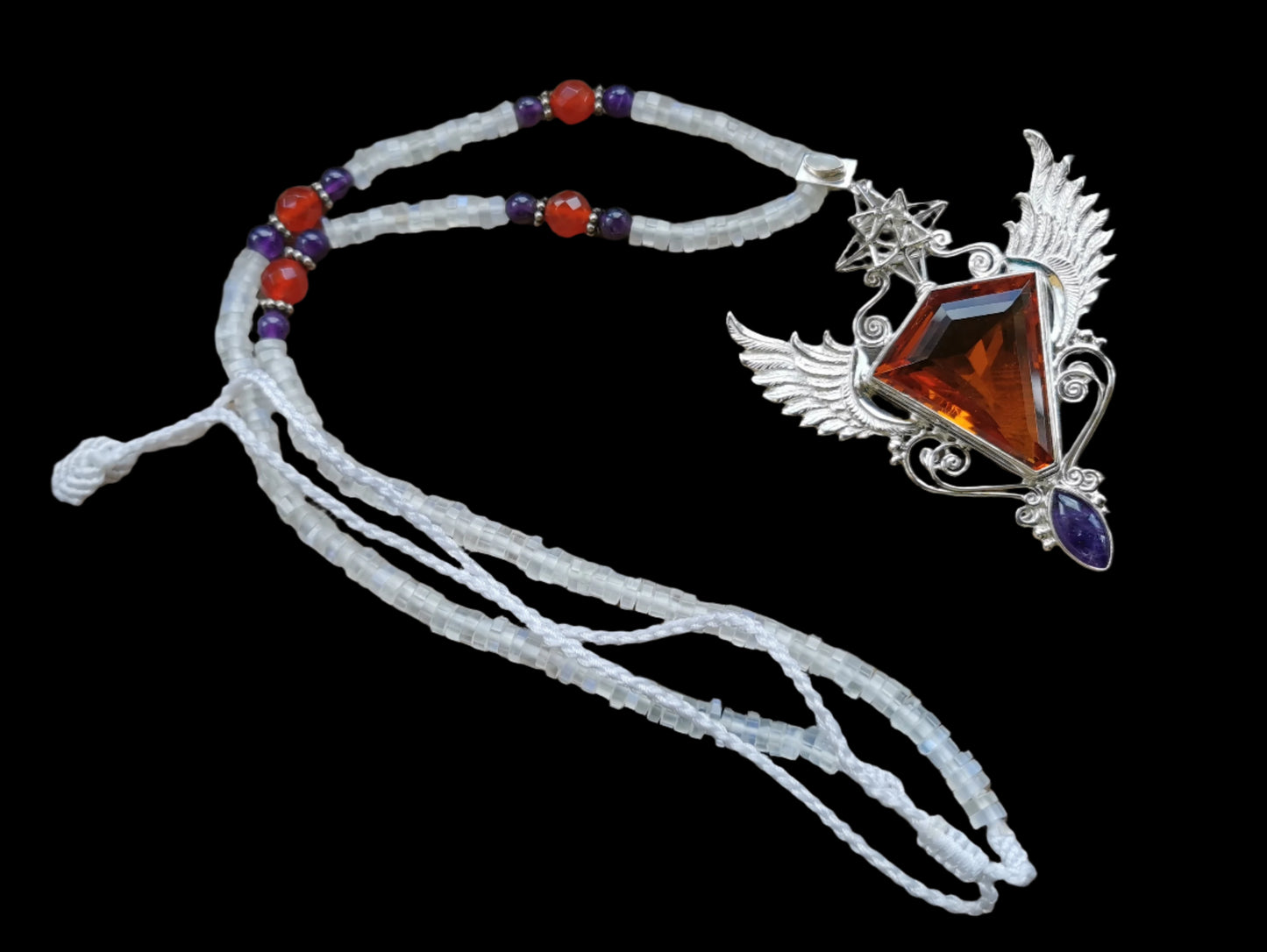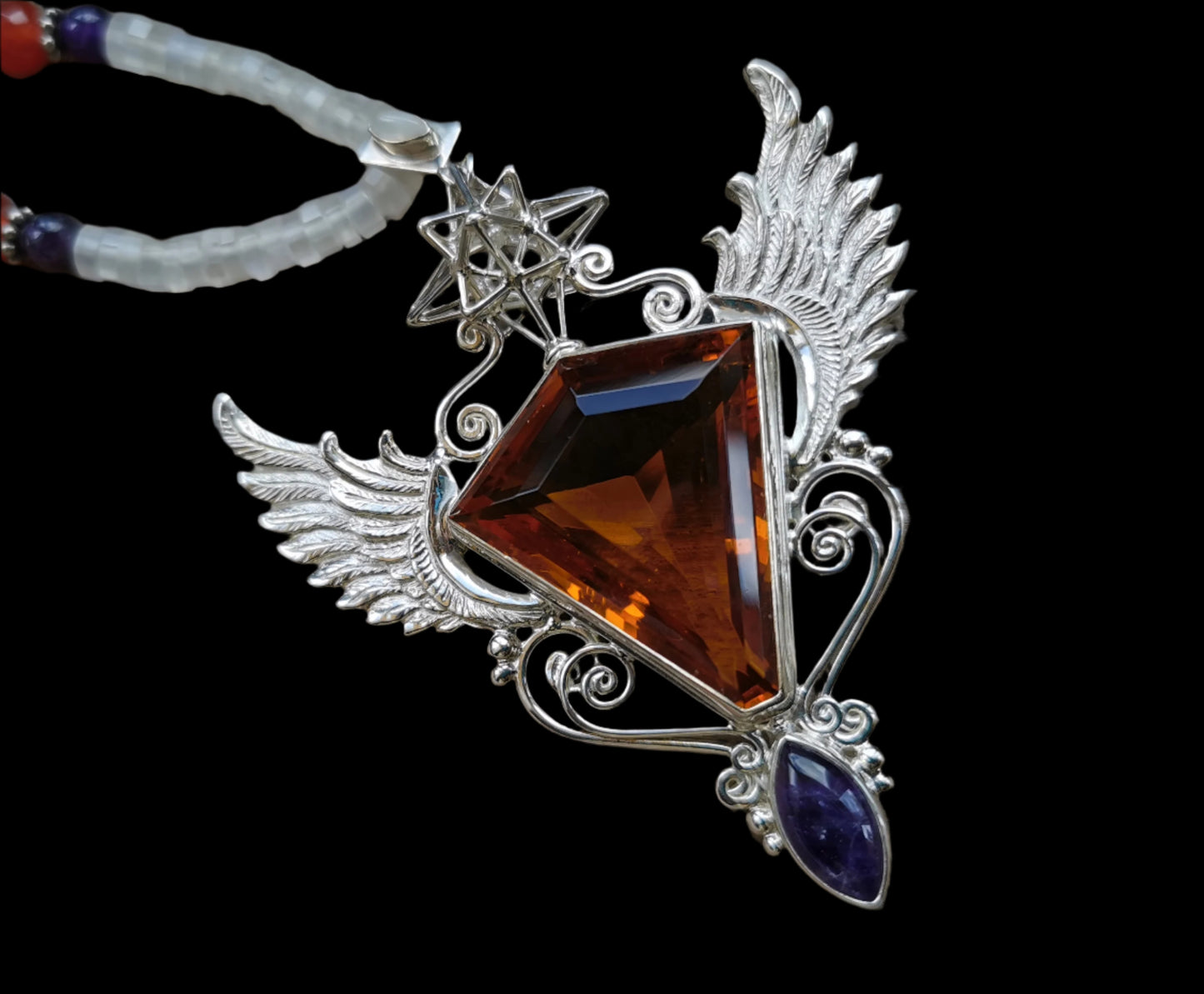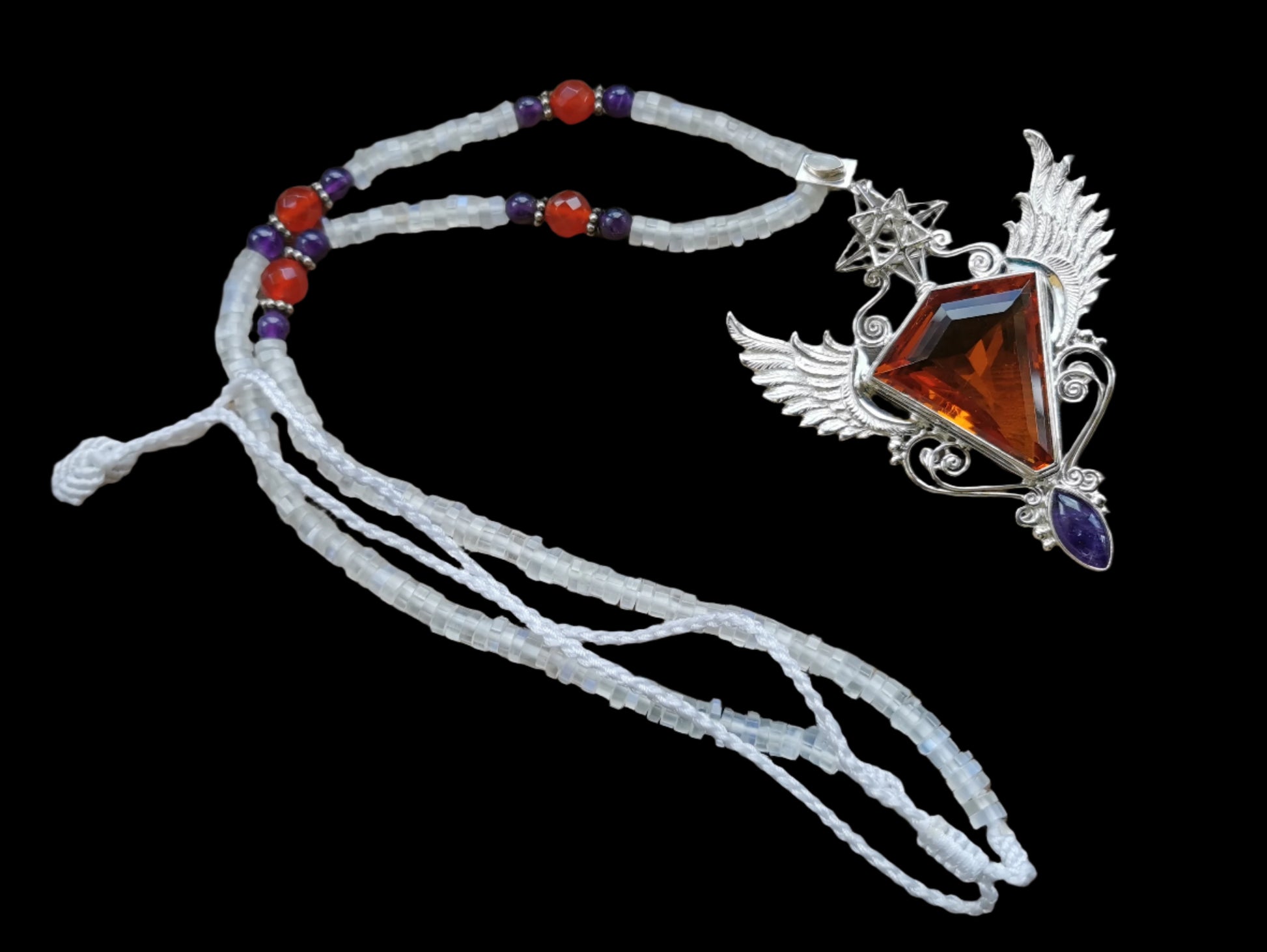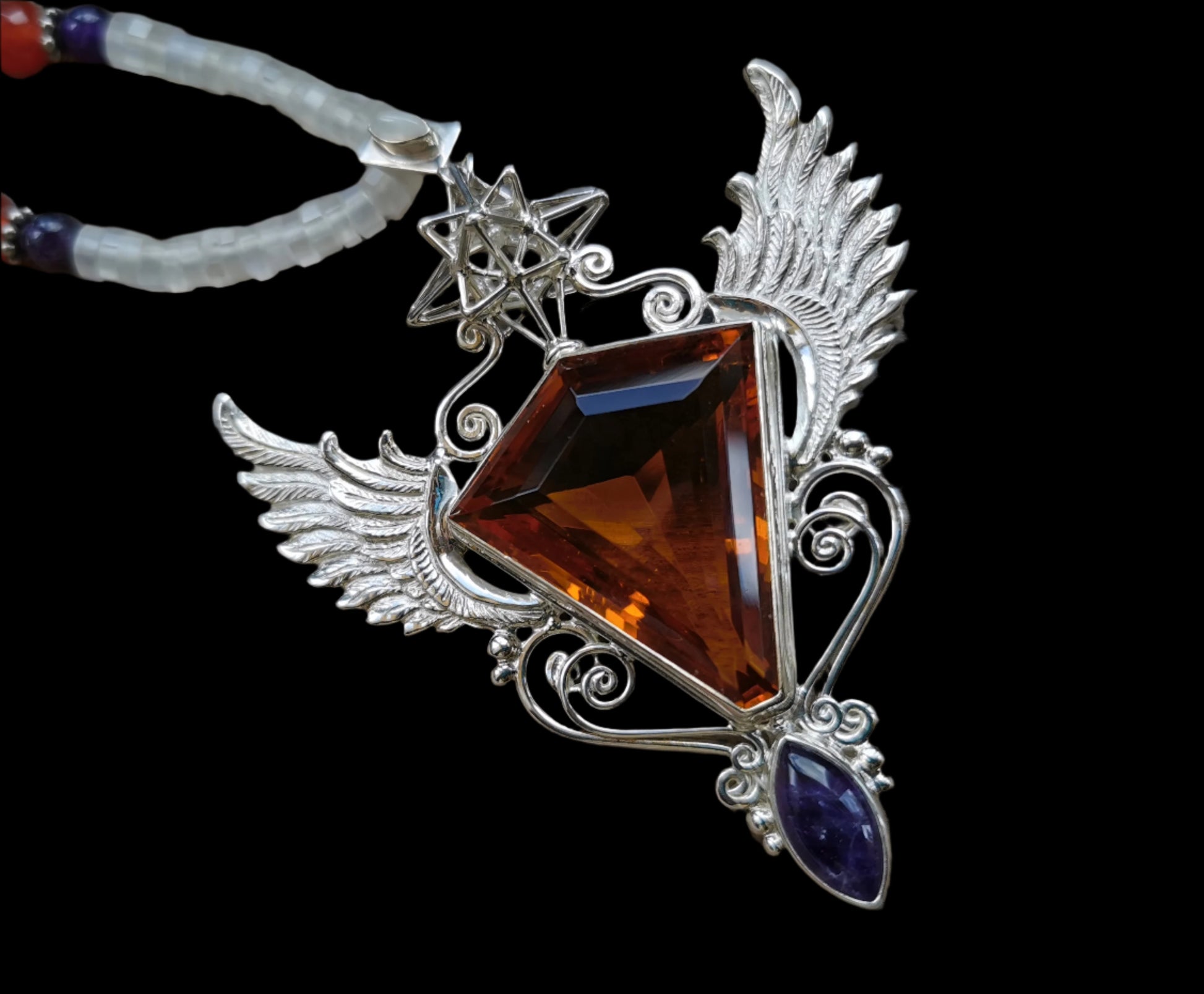Portal Glastonbury
Ref.NC0057
Ref.NC0057
Couldn't load pickup availability
Ref.NC0057 - Necklace with silver Heart Star geometry+wings, citrine gem carved shield, moonstone [bale, and amethyst gemstones; beads: moonstone, carnelian, and amethyst gems.
The shield, as a symbol, carries profound and multifaceted meanings across cultures, history, and contexts, rooted in its primary function as a protective tool in warfare. Its symbolism extends beyond the physical to encompass spiritual, psychological, and societal dimensions, representing defense, strength, honor, and identity.
Symbolic Significance of the Shield
The shield, one of humanity’s oldest tools of defense, is a potent symbol that resonates across cultures, histories, and contexts. Far beyond its practical role in protecting against physical attacks, the shield carries deep metaphorical meanings, embodying concepts of protection, strength, honor, identity, unity, and spiritual guardianship. Its enduring presence in art, literature, religion, and modern culture underscores its versatility as a symbol of both individual and collective resilience.
Protection and Guardianship
At its essence, the shield symbolizes protection against threats, whether physical, emotional, spiritual, or societal. In ancient warfare, it was a literal barrier against arrows, swords, or spears, but its symbolic role extends to safeguarding against intangible dangers like fear, chaos, or malevolent forces. In religious traditions, the shield often represents divine protection. For example, in Christianity, the “shield of faith” (Ephesians 6:16) is described as a defense against spiritual attacks, embodying trust in God’s safeguarding power. Similarly, in Judaism, God is referred to as a “shield” (Psalm 3:3), symbolizing refuge and security. In secular contexts, the shield represents emotional or psychological boundaries, protecting one’s inner self from harm or external pressures.
Strength and Resilience
A shield’s ability to withstand blows makes it a powerful symbol of strength and endurance. It reflects the inner fortitude required to face adversity, whether in battle, personal struggles, or societal challenges. The shield evokes courage, determination, and the resolve to stand firm in the face of danger. In stories and myths, heroes wielding shields—such as Achilles with his legendary shield in Greek mythology—embody unyielding resilience, their shields serving as extensions of their indomitable spirit. This symbolism persists in modern metaphors, where “holding up a shield” implies standing strong against criticism, hardship, or oppression.
Honor and Duty
Shields have long been associated with honor, duty, and loyalty, particularly in martial cultures. In medieval Europe, a knight’s shield was a sacred object, often emblazoned with a coat of arms that declared their allegiance, lineage, and commitment to chivalric ideals. Losing a shield in battle was a profound disgrace, as it signified a failure to uphold one’s responsibilities. This connection to duty extends to other cultures, such as the samurai of feudal Japan, whose armor (including shield-like elements) symbolized their unwavering loyalty to their lord. The shield thus represents the weight of obligation and the pride of fulfilling one’s role, whether to family, community, or a higher cause.
Identity and Heritage
Shields often bear unique designs, such as crests, emblems, or totems, making them powerful symbols of personal and collective identity. In ancient Greece, hoplite warriors carried shields marked with symbols of their city-state, like the lambda (Λ) of Sparta, proclaiming their civic pride. In African cultures, such as the Zulu, shields were crafted with specific patterns or colors to signify clan affiliation or social status, reinforcing tribal identity. Similarly, Native American warriors painted shields with spiritual visions or animal totems, connecting them to their ancestors and cultural heritage. The shield’s role as a canvas for identity persists in modern contexts, such as heraldic symbols on family crests or logos on sports team shields, which foster a sense of belonging and pride.
Unity and Collective Strength
In military tactics, shields were often used collectively to protect groups, symbolizing unity and solidarity. The Roman testudo formation, where legionaries interlocked their scuta (rectangular shields) to form a protective “tortoise” shell, is a striking example of shields representing communal defense. This imagery extends to societal metaphors, where shields symbolize the shared values, traditions, or institutions that protect a community. For instance, a family might be described as a “shield” for its members, offering emotional and social support. In modern activism, shields—whether literal (used in protests) or figurative (representing advocacy)—symbolize collective resistance against injustice, uniting individuals for a common cause.
Spiritual and Cosmic Protection
In many traditions, shields carry spiritual significance, acting as talismans or sacred objects. Among Native American tribes, shields were often imbued with spiritual power, decorated with symbols from visions or dreams to invoke protection from ancestors or supernatural forces. In Norse mythology, shields like the Svalinn (a mythical shield that protects the earth from the sun’s heat) symbolize cosmic guardianship, maintaining balance in the universe. In Hinduism, deities like Vishnu are depicted with shields, representing their role as protectors of dharma (cosmic order). These examples highlight the shield’s role as a bridge between the human and divine, warding off chaos and preserving harmony.
Historical and Cultural Contexts
Ancient Civilizations: In Mesopotamia and ancient Egypt, shields were both practical and ceremonial, often symbolizing royal authority and divine endorsement. Egyptian pharaohs were depicted with ornate shields, signifying their role as protectors of the land and its people.
Classical Greece and Rome: Greek hoplites used large, round shields (aspis) that symbolized their duty to the polis, while Roman legionaries’ scuta represented the disciplined strength of the empire. Shields were often personalized, reinforcing individual and collective identity.
Medieval Europe: Heraldic shields were central to knightly culture, displaying coats of arms that encoded family history, alliances, and social status. They were symbols of chivalry, with knights swearing oaths on their shields to uphold justice and honor.
Indigenous Cultures: In African societies, such as the Maasai or Zulu, shields were crafted from hide and decorated with tribal motifs, symbolizing bravery, unity, and cultural pride. Native American shields, often circular to reflect the sacred hoop of life, were spiritual tools, believed to carry protective power.
Asian Traditions: In ancient China, shields were used in warfare and ritual, symbolizing imperial authority and cosmic balance. In Japan, while shields were less common, armor elements served similar symbolic roles, representing loyalty and martial virtue.
Modern Symbolism and Applications
In contemporary contexts, the shield retains its protective and unifying symbolism, adapting to new domains:
Law Enforcement and Authority: In many countries, a police officer’s badge is called a “shield,” symbolizing their role as protectors of public safety and order. This reflects the shield’s enduring association with guardianship and responsibility.
Pop Culture and Media: In popular culture, shields are iconic symbols of heroism. Captain America’s vibranium shield in Marvel comics and films embodies integrity, defense of justice, and resilience, making it a modern emblem of heroism. In fantasy settings, like The Legend of Zelda, shields represent the protagonist’s readiness to face challenges.
Technology and Science: The term “shield” is used metaphorically in technology, such as cybersecurity “shields” that protect against digital threats or heat shields on spacecraft that safeguard against extreme conditions. These uses extend the shield’s symbolism to modern frontiers, representing defense against invisible or futuristic dangers.
Psychological and Social Metaphors: In psychology, shields symbolize emotional defenses or coping mechanisms that protect against trauma or stress. In social movements, “shielding” vulnerable groups—through advocacy or physical protection—reflects the shield’s role as a symbol of solidarity and care.
Sports and Branding: In sports, shields appear in logos (e.g., soccer club crests) or as trophies, symbolizing team unity, achievement, and pride. Corporate logos sometimes incorporate shield imagery to convey trust, reliability, and protection (e.g., insurance companies).
The shield’s symbolic significance lies in its ability to embody both practical and profound meanings. As a tool of defense, it represents protection, strength, and resilience; as a bearer of emblems, it signifies identity, honor, and heritage; as a collective formation, it evokes unity and solidarity. Across ancient myths, religious texts, and modern culture, the shield remains a universal symbol of guardianship, reflecting humanity’s enduring need for safety, pride, and connection. Its versatility ensures its relevance, whether on a battlefield, in a spiritual ritual, or as a metaphor for personal growth.
Wings are often imbued with profound meaning:
- Spiritual Transcendence: Wings symbolize the soul's journey towards higher consciousness or enlightenment, representing the aspiration to rise above the mundane or material world.
- Freedom: They signify liberation from earthly constraints, whether those are physical, emotional, or spiritual bonds.
- Protection: Often seen as a sign of spiritual protection, offering comfort and a sense of safety on one's spiritual path.
- Transformation: Like the metamorphosis of a caterpillar into a butterfly, wings represent personal transformation, rebirth, or the shedding of old ways to embrace new growth.
- Connection Between Worlds: Wings can symbolize the ability to move between different realms or states of existence, bridging the earthly with the spiritual, the known with the unknown.
- Empowerment: They embody the idea of gaining strength or power, often related to overcoming challenges or achieving personal empowerment.
- Healing: In some interpretations, wings are associated with healing energies, suggesting the capacity to heal oneself or others through spiritual means.
- Manifestation: The act of spreading wings can be seen as a metaphor for manifesting one's dreams or desires, taking flight towards one's goals.
- Intuition and Insight: Wings might also represent heightened intuition or insight, the ability to 'fly' above situations for a broader perspective.
These symbols encourage individuals to seek personal growth, embrace change, and connect with their higher selves or Spirit. Wings are not just about physical flight but about the journey of the soul.
Heart Star
Magnetic
Love and compassion, emotional balance, the healing of abandonment and betrayal.
The Heart Star, the central fractal within the Human hologram, forms a junction through which all systems of the Human matrix are interwoven. Within the Covenant embedded in the Human matrix the Heart Star fractal is the fulcrum point through which we embody the Benevolence of Creation. It is in frequency resonance with the Heart chakra, facilitating the cleansing of the emotional body.
The Heart Star brings Stellar Radiance into resonance with the central fractal of the Human matrix, in addition to the benefits of the Iconic Terra Prana Sphere which forms its centre.
This form protects against unbalanced electric energies, e.g., computers, televisions, etc.
Size: 425mm/16.73in [max] 250mm/9.84in [min] 83mm/3.27in [pendant] approx.




